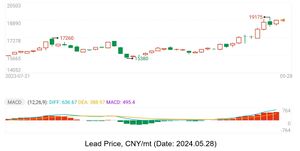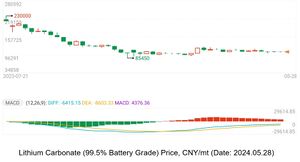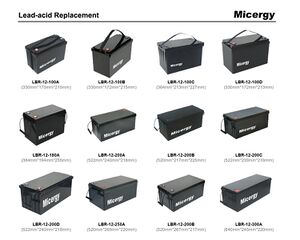Difference between revisions of "Lead is rising, lithium carbonate is falling, time for lead-acid replacement with lithium batteries."
***** (***** | *****) (Lead is rising, lithium carbonate is falling, time for lead-acid replacement with lithium batteries.) Tag: 2017 source edit |
***** (***** | *****) |
||
| Line 38: | Line 38: | ||
Traditional Lead Acid manufacturers are struggling and soon will be outdated by the market, LiFePO4 batteries have unbeatable advantages over Lead Acid Battery in both product performance and cost performance | Traditional Lead Acid manufacturers are struggling and soon will be outdated by the market, LiFePO4 batteries have unbeatable advantages over Lead Acid Battery in both product performance and cost performance | ||
[[File:Cost difference between LiFePO4 & Lead Acid.png|thumb|https://www.micergy.com/blog-ct-01.html]] | [[File:Cost difference between LiFePO4 & Lead Acid.png|thumb|https://www.micergy.com/blog-ct-01.html]] | ||
| + | [[File:Micergy lead acid replacement housing.jpg|thumb|https://www.micergy.com/blog-ct-01.html]] | ||
If you don't like the appearance of traditional lead acid battery, the design can be customized upon requirements, welcome to drop an email to info@micergy.com to learn more about Micergy's lead acid battery replacement solution, we will provide you with an unbeatable price and service to compete. | If you don't like the appearance of traditional lead acid battery, the design can be customized upon requirements, welcome to drop an email to info@micergy.com to learn more about Micergy's lead acid battery replacement solution, we will provide you with an unbeatable price and service to compete. | ||
About Micergy | About Micergy | ||
Latest revision as of 11:14, 30 May 2024
At the beginning of 2024, we witnessed a wave of "Higher and Longer" unilateral upward trends in lead prices. At the end of March, macro inflation expectations were traded under macro reflation expectations, coupled with fundamental benefits such as the introduction of new national standards in China, trade-in policies, and reverse invoicing. Multiple factors have contributed to this cycle of repeated incidents, and lead price has recently hit a six-year high. The specific reasons why lead price increases are: 1. Decrease in global lead mine production In recent years, the difficulty and cost of mining lead mines have gradually increased, and global lead mine production has declined. 2. Increased demand With the continuous development of the economy, first of all, as the consumption of lead-acid batteries, lead alloys and lead oxide increases, or the prosperity of electric bicycles, energy storage and communication base stations increases, the demand increases significantly, which drives up the price of lead. Furthermore, lead and its alloys are increasingly used in automobiles, electronics, construction and other industries. The demand for lead in these industries is increasing year by year, which will also drive up the price of lead ingots. 3. Policies and measures On the one hand, import and export policies. For example, the cancellation of export tax rebates for refined lead and lead products or the export restrictions on energy-consuming products will reduce the export of refined lead and lead products, thereby affecting the rise in lead prices. On the other hand, some countries have introduced policies and measures to protect the environment, which has restricted the development of the lead industry. 4. Production cost Production cost is the basic factor affecting lead prices. The production cost of primary lead is affected by the price of by-products such as silver and sulfuric acid and lead ore processing fees, while the production of secondary lead is affected by the recycling price of scrap lead batteries. On the contrary, the price of lithium carbonate dropped to 100,000 yuan/ton after hitting a record high of 600,000 yuan/ton in 2022, which is also a story of ups and downs. In 2016, driven by the Chinese Government policies, the development of the new energy vehicle market entered a fast track. The supply of lithium carbonate exceeded the demand. Global lithium carbonate companies began to raise prices. With scarce resources coupled with the explosion of demand, the prices of lithium carbonate also began to rise sharply. In May 2016, its price reached up to 170,000 yuan/ton. Soon thereafter, new energy vehicle policies began to change, and relevant subsidies could not be provided in time. The market weakness and stagnant demand caused the price of lithium carbonate to begin to fall. From the third quarter of 2016 to the first quarter of 2017, the price of lithium carbonate fell. It has been stable at around 120,000 yuan/ton. In the next two years, the epidemic hindered the development of the overall economy. At this time, the development of lithium carbonate was accelerated, the lithium battery industry developed steadily, and the supply and demand of lithium carbonate in the market were relatively balanced. The price of lithium carbonate showed a long-term downward trend. By the beginning of 2020, its price was even the same as that of lithium carbonate. Prices were close before 2015. By 2021, the "dual carbon" strategy accelerate, new energy develop rapidly, sales of new energy vehicles will increase sharply, and the vigorous development of the energy storage industry will usher in a major explosion in the lithium battery industry. The price of lithium carbonate rises, and the market will temporarily supply exceeds demand, soaring to a maximum of 600,000 yuan/ton in just one year in 2022. In 2023, the price of lithium carbonate, which has reached its peak, will begin to fall off a cliff. Battery-grade lithium carbonate reached a high price of nearly 600,000 yuan/ton in November 2022 and then began to decline, falling below 200,000 yuan/ton in April 2023. In the same month, its price fell below 180,000 yuan/ton, bottomed out in May, and reached over 200,000 yuan/ton. A month later, the price reached a high of 315,000 yuan/ton and then fell again. In September, it fell below 200,000 yuan/ton again. With the promotion of policies and the unprecedented enthusiasm of the market, companies began to increase capital and expand production on a large scale. After a period of time, calls for overcapacity emerged one after another; the "roller coaster" lithium price also made it difficult for the lithium battery industry to operate under high pressure, and the entire industry chain The stable and healthy development of China has been seriously affected. Even so, the industry still believes that the price of lithium carbonate of 100,000 yuan/ton still has room for decline. Many people believe that the price bottom line of lithium carbonate will be reached after reaching 80,000 yuan/ton. Some even think that 60,000 yuan/ton is the bottom price.
Time for lead-acid replacement with lithium batteries. The diametrically opposite trends in lead prices and lithium carbonate prices have also made us rethink that the era of lead-acid substitution may have officially arrived. As we all know, upgrading the lead-acid battery to a LiFePO4 battery can bring many benefits, such as higher capacity, lower weight, longer lifespan, and lower maintenance. LiFePO4 batteries can also improve the performance and reliability of your system, and reduce the risk of failure and damage, but cost is a problem can’t be neglected, so in the past, when selling lead-acid substitution products like LiFePO4 battery, we prefer to focused more on the lower lifetime cost of lithium iron phosphate batteries brought about by the long cycle time, the implication is that the cost of lithium iron phosphate batteries is higher than that of lead-acid batteries, but now, we can very confidently declare that the cost of lithium iron phosphate batteries is the same as that of lead-acid batteries, and at the same time, it has performance and lifespan that far exceeds that of lead-acid batteries. Let's do a detailed comparison between LiFePO4 battery and Lead Acid battery
- Lifespan: LiFePO4 battery is 10-20 times longer lifespan than lead acid battery
- Weight: LiFePO4 battery are significantly lighter than lead-acid batteries, Typically 1/3-2/3, more application scenario and user-friendly
- Energy Density: LiFePO4 battery with energy density of 160-180wh/kg, compared with lead acid with 50-70wh/kg
- Charging Time: LiFePO4 battery is 4 times faster than lead acid battery on charging speed
- Constant Power Delivery: LiFePO4 battery deliver the same amount of power during the entire discharge cycle, lead acid battery start strong, but dissipates
- Depth of Discharge : LiFePO4 battery can discharge up to 100% for daily usage, lead acid lifespan will drop sharply if discharged deeply and the discharging capacity also drop sharply under high capacity rating
- Safety: LiFePO4 battery protected by BMS, Lead acid is easy to overheating and explosion if left unchecked during charging or discharging
- Self-discharge Rate: Lead acid battery is 5 times greater than LiFePO4 battery, if discharge to 0, the plates become sulfated and the lead acid battery will easy to fail and broken
- Maintenance: LiFePO4 battery with BMS and low self-discharge rate is easy maintenance with charge and discharge cycles once every 3-6 months, Lead acid need frequent manual monitoring and maintenance
- Environmental Friendliness: LiFePO4 is green battery, Lead can cause metabolic, reproductive and neurological diseases
- Temperature Performance: LiFePO4 battery is superior than lead acid in high temperature, cold temperature cause capacity reduction for both battery
- Installation: LiFePO4 battery has no restriction in installation orientation, lead acid battery need to consider ventilation and leak risk
- Usable Capacity: LiFePO4 battery can discharge upto 100%, Lead acid is recommend to discharge up to 50%, which is half of the usable capacity
Traditional Lead Acid manufacturers are struggling and soon will be outdated by the market, LiFePO4 batteries have unbeatable advantages over Lead Acid Battery in both product performance and cost performance
If you don't like the appearance of traditional lead acid battery, the design can be customized upon requirements, welcome to drop an email to info@micergy.com to learn more about Micergy's lead acid battery replacement solution, we will provide you with an unbeatable price and service to compete. About Micergy Micergy started lithium battery manufacturing in 2009 and provides custom lithium battery products for different sectors, including energy storage batteries, lighting electric vehicle batteries, and custom batteries for golf carts, Marine, RV, and Forklifts. Besides, not limiting ourselves to the R&D of BMS to protect the battery and lengthen the lifespan, relying on the competitiveness of the battery, Micergy further embraces the IoT technology and developed comprehensive 'Energy + IoT' solutions for various sectors to solve the affordability problem of product with a high upfront cost.
Follow Micergy by visiting: https://www.micergy.com or drop an email to info@micergy.com
Micergy specializes in designing and manufacturing battery packs and e-mobility solutions, please get in touch with us if you have any requests for bespoke battery packs and low-speed e-mobility solutions.
Micergy specializes in designing and manufacturing battery packs and e-mobility solutions, please get in touch with us if you have any requests for bespoke battery packs and low-speed e-mobility solutions.

























